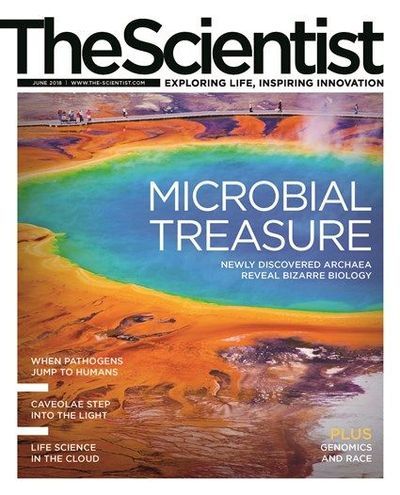Login
SubscribeCover Story

Archaea Family Tree Blossoms, Thanks to Genomics
Amber Dance | Jun 1, 2018 | 10+ min read
Identification of new archaea species elucidates the domain’s unique biology and sheds light on its relationship to eukaryotes.
Features

Predicting Future Zoonotic Disease Outbreaks
Ashley Yeager | Jun 1, 2018 | 10+ min read
A step-by-step study of diseases that jump species gives subtle clues about future epidemics.

New Technologies Shed Light on Caveolae
Ben Nichols | Jun 1, 2018 | 10+ min read
The functions of the cellular invaginations identified more than half a century ago are now beginning to be understood in detail.
Contributors
Contributors
Contributors
Meet some of the people featured in the June 2018 issue of The Scientist.
Editorial
From Little Things Big Things Grow
From Little Things Big Things Grow
We should take comfort in the fact that life on Earth had such unassuming, shared beginnings.
Speaking of Science
Ten-Minute Sabbatical
Ten-Minute Sabbatical
Take a break from the bench to puzzle and peruse.
Notebook
How Corpse-Eating Beetles Avoid Infection
How Corpse-Eating Beetles Avoid Infection
Some beetle species may have evolved to tunnel into the ground to escape the pathogens that abound on dead and rotting animals.
Why Bats Make Such Good Viral Hosts
Why Bats Make Such Good Viral Hosts
The bat version of the STING protein helps dampen the mammals' immune response to infection, researchers have found.
Surveying Biodiversity with Leeches
Surveying Biodiversity with Leeches
Scientists are searching for signatures of mammals within the blood meals of the invertebrates.
Researchers Grow Veggies in Space
Researchers Grow Veggies in Space
Experiments to cultivate greens on the International Space Station and in simulated Martian environments pave the way for feeding crews during deep space missions.
Thought Experiment
Opinion: Archaea Is Our Evolutionary Sister, Not Mother
Opinion: Archaea Is Our Evolutionary Sister, Not Mother
The ancient organisms appear to be more closely related to eukaryotes than previously appreciated.
Modus Operandi
Gene Expression Analysis Gets Gassy
Gene Expression Analysis Gets Gassy
Soil scientists use a gas-producing reporter system to assess gene activity in bacteria.
The Literature
Condensin Folds DNA Through Loop Extrusion
Condensin Folds DNA Through Loop Extrusion
By observing the activity of a protein complex in real time, researchers have uncovered new evidence for a long-standing theory.
Incomplete Immunity
Incomplete Immunity
By combining experimental data with computer models, researchers were able to predict a pathogen’s evolution toward more virulence.
Productivity Paradox
Productivity Paradox
During the last ice age, there wasn’t much plant matter to eat on northern steppes, but herbivorous woolly mammoths were abundant. How did they survive?
Profile
Trauma Biologist: A Profile of Israel Liberzon
Trauma Biologist: A Profile of Israel Liberzon
The University of Michigan neuroscientist has developed therapies for patients with PTSD and laboratory models to understand its basis.
Scientist to Watch
Youssef Belkhadir Deciphers Plants’ Signaling Soundtrack
Youssef Belkhadir Deciphers Plants’ Signaling Soundtrack
An entrepreneurial attitude helped this Vienna-based researcher begin to unravel the complex receptor network that Arabidopsis uses to develop and defend itself.
Lab Tools
Using Mimics to Get Around Antibodies’ Limitations
Using Mimics to Get Around Antibodies’ Limitations
Synthetic and natural alternatives to traditional antibodies offer more control, specificity, and reproducibility.
Bio Business
Bringing the Internet of Things into the Lab
Bringing the Internet of Things into the Lab
The IoT can link up many facets of research—from laboratory equipment to ideas—but scientists must be ready for the questions its implementation could raise.
Reading Frames
Race Is Not a Genomic Phenomenon
Race Is Not a Genomic Phenomenon
Rather, DNA sequencing can help us parse our ancestry, a subtle but important distinction.
Foundations
China’s Flowers, 1922-1949
China’s Flowers, 1922-1949
Austrian-American botanist Joseph Rock collected thousands of plant samples in his 27 years in the Middle Kingdom, leaving after the Communist Party’s takeover.


















